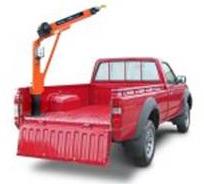DEVELOPMENTS IN VEHICLE MOUNTED LOAD HANDLING
08 July 2010
Despite the tough market conditions in the commercial vehicle sector and many of the industries that rely on these everyday workhorses there have been some interesting developments in load handling equipment that present innovative solutions for end users.
 Many businesses now routinely fit devices such as cranes and platform lifts on to their vehicles to provide a safe and efficient way for employees to complete tasks without manual handling.
Many businesses now routinely fit devices such as cranes and platform lifts on to their vehicles to provide a safe and efficient way for employees to complete tasks without manual handling. The benefits in terms of lower industrial injury rates, fewer accidents and improved overall productivity outweigh the costs but there remains the perceived problem of reduced carrying capacity on the vehicle. The ability to transport a larger range of tools and materials to a job can make the difference between profit and loss by avoiding the need for repeat visits and unnecessary and costly additional mileage. Load handling equipment should not get in the way of this.
Penny Hydraulics has responded by undertaking a review across its range to design and engineer weight out of its products without compromising on performance and reliability.
The company has used advanced 3D modelling and stress analysis techniques, believed to be unique in the sector, to analyse every aspect of its designs and create new components with different materials, shapes and profiles that are much lighter than the originals.
The company has also developed a range of new platforms for its Single Wheel Lift, Easyloader Tail Lift and Step Lift models including new lightweight aluminium and galvanised mesh, offering a wider choice to customers. The original Single Wheel Lift, for example, weighed 99kg but the new lightweight version weighs under 50kg.
This 50 per cent weight saving means that vehicles can carry more stock, tools and equipment without exceeding their safe and legal loading capacities. This is most important on the increasingly popular three and half tonne class vehicles where space and weight limitations can be particularly tight.
Vehicle mounted cranes are also evolving. Customers are now demanding full hydraulic operation for smaller cranes to introduce new levels of performance and safety into their load handling. Hydraulic lift and slew enable handling to be controlled precisely and accurately without any risk of unexpected movements that can be a potential issue with more basic designs, especially if the vehicle is parked on uneven ground or a slope.
Two new cranes introduced by Penny Hydraulics in the past year now offer fully hydraulic mechanisms in the under-one-tonne range for the first time in the market. The addition of an electric or hydraulic winch to even the smallest cranes can add to its versatility by allowing loads to be handled below ground level, which is essential in many construction, utility and service applications. Features such as remote control, hard wired or radio controlled, that allow operators to remain safely clear of the handling area are among some of the other innovations that are now becoming the norm rather than the exception.
There are signs that the market is becoming more sophisticated and customers are certainly asking for handling solutions that are matched to their specific requirements rather than simply accepting the “standard” models on offer.
Manufacturers or suppliers who are unwilling or unable to meet these demands are missing potentially valuable opportunities. Those that offer a degree of flexibility to work with customers and provide bespoke solutions are likely to be better placed in the future to take advantage of new trends.
In many cases these bespoke products are not difficult to develop. Often it is simply a case of devising a new attachment for a crane or a special cradle to support a particular load on a platform lift. For example, Penny Hydraulics recently developed a special spreader attachment for its cranes that allows fully IBC and dumpy bags to be lifted safely even when their straps could not be drawn together for lifting by a basic hook.
Sometimes the handling requirement can be more complex and novel solutions are needed. A good example of this is a totally new type of tracked mobile crane developed jointly by Hinowa and Penny Hydraulics.
Two versions are available based around proven and established products from each manufacturer. An electric model with a maximum load of 630kg is small and compact and ideally suited to confined areas or indoor applications.
For larger applications a petrol engine version can handle items weighing up to 1200kg. Both models allow loads to be handled over off-road and rough terrain areas where conventional equipment or vehicle mounted solutions cannot easily be used. Collaborations of this type between leading manufacturers in their respective fields offer novel solutions that would otherwise be unavailable to the market.
Whether it is through greater collaboration with complementary manufacturers or by devising new products of their own it is clear that companies who are willing to continue with their research and development during the quiet times will be well placed to meet current market expectations as well as greater demand when the upturn surely comes.
Penny Hydraulics (www.pennyhydraulics.com) designs, manufactures and services lifting and load handling equipment for use in a wide range of applications. Products include the Swing Lift range of medium duty cranes for use on pick-ups, drop-sides and flat-beds and the Step Lift, Load Lift and Tail Lift lifting platform ranges for use on pick-ups, drop-sides and vans.
The company also manufactures the Mezz Lift for handling loads between ground floor and mezzanines and specialist equipment for handling wheels, tyres and barrels in vehicles and at customers’ premises.
Other Press Releases By This Company
- 29/11/2010 - Cranes of Vehicle Lifts for Load Handling?




